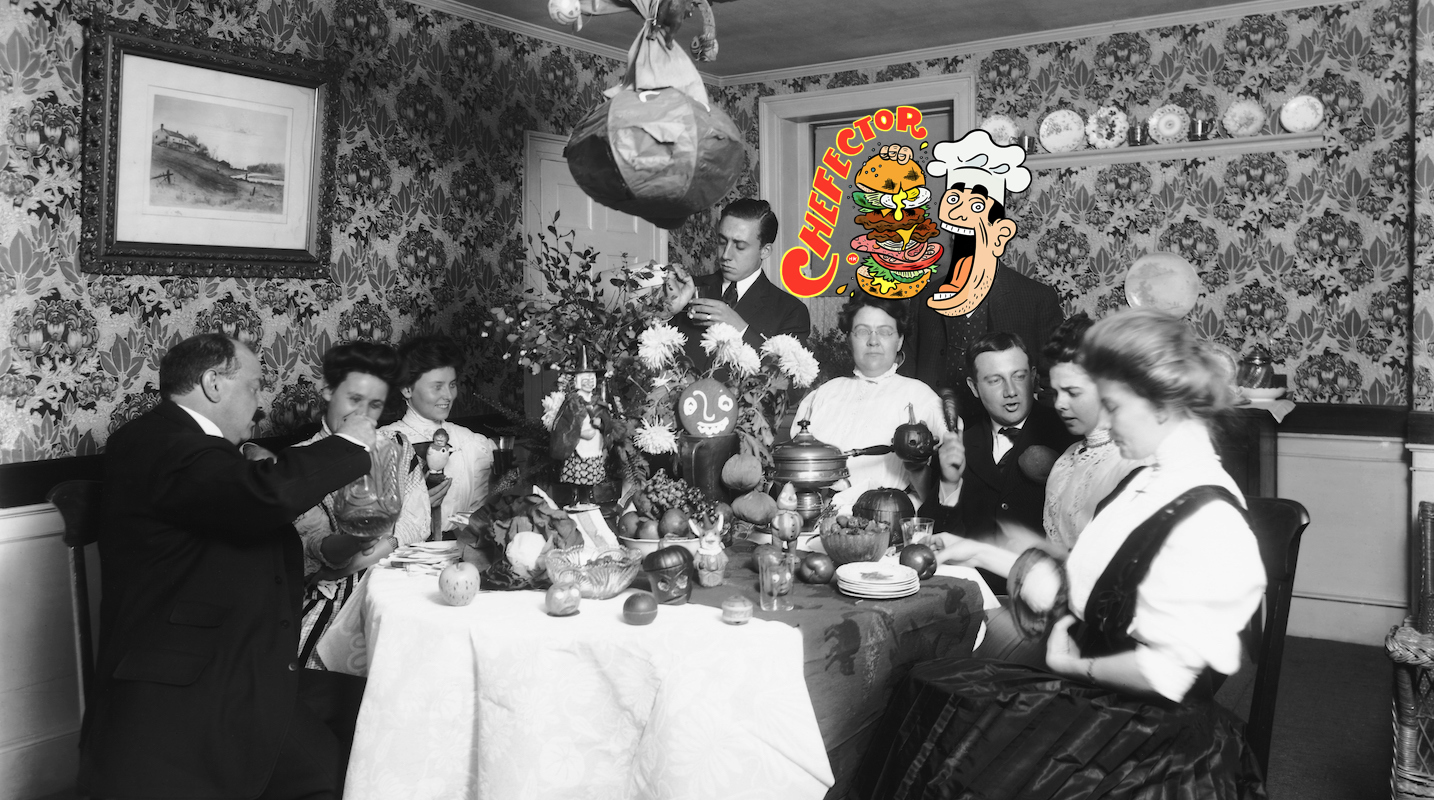The dinner party has a well-earned reputation as a gauntlet of class anxiety, snobbery, and social exclusion. Use the right fork; bring the right wine; take off your shoes right the fuck now before you step even one of your disgusting feet onto my nice floor. It’s also deeply gendered, of course. The gift you bring to parties and holiday dinners has only recently begun to shed the gendered name of “hostess” gift—an offering to the sacrifices traditionally made by wives and mothers on the altar of Occasion, the hours of cooking and scrubbing and tidying up the scattered paraphernalia of normal and richly lived life that others must never see. Think of Marge Simpson putting the toilet seats in the dishwasher and biting her candles so that they’re all the same height.
Dinner partying in 2024 can be almost as tiresome, if you let it. It can be competitive and boasty, an opportunity to show off just how beautiful your plates are, how rich you are, how convincingly you can make the food look like Alison Roman herself made it. The “Dîner en Blanc,” a huge, ticketed “dinner party” where thousands of berks pay to eat outside, bring their own white tablecloths and napkins, and talk a lot about Proper Dining Etiquette, makes me want to eat drive-thru Burger King for the rest of my life. Stop doing that! Jesus Christ!
It doesn’t have to be this way. You can simply make dinner for your friends and be normal about it. And I will help you do it, if you join my Perfectly Fine Dinner Party Club.
These will be dinner parties for people with mismatched plates and one too few wine glasses. They are absolutely not catered, for God’s sake. They can be Instagrammed, but only if the photos are sort of shit and the food doesn’t look as good as it tastes. They are thrown only for people who wouldn’t care if you fucked up a dish and had to serve a frozen lasagna. They are expressions of love before they are chances to show off. (But you can show off a bit, too.)
I love making dinner for friends, and I don’t love going out quite as much. I do love eating at restaurants, of course; they make the best food! But decades of migraines and related anxiety about being trapped in loud places, plus the pandemic years, plus the general reassessment of social priorities that comes with your 30s, have tipped my preferences in favor of hosting at home. Living in an apartment that is almost big enough for a dining table also helps (though I used to make dinner for friends in my old apartment, where there were exactly two seats at the breakfast counter, too).
There are a few rules:
- These dinner parties are only for people you like. I’m not against, for example, a guest saying “Oh, my friend Glondora is in town that night, can she come?” Throw caution to the wind and assume your friend’s taste in Glondoras is fine, if you want. What I’m trying to avoid here is the episode of Frasier where the brothers spend all episode fighting over who they’re going to invite to a dinner party, weighing up the Hated Guests against the Tolerable Guests, all in service of hosting one couple—who, turns out, don’t really like the Cranes anyway. The Perfectly Fine Dinner Party Club is for hosting people whose company you enjoy, and that’s that. You can mix and match groups of friends, and have people bring their iffy spouses. Do whatever you like, really. Just don’t use Perfectly Fine Dinner Party Club as a means of social climbing at the expense of a good time. Lateral and downward moves only. This isn’t Cool Dinner Party Club.
- There is no minimum guest count. Host as many as your place can fit, or just one other person. We are interpreting “party” as loosely as we like. Use it to set menus for your next D&D night, for all I care.
- Second only to the love of your friends is the food. I’m not going to tell you that you simply must buy the best meat from the local butcher, vegetables at the farmers market, or organic wine. If you have the money, please go ahead! Of course these things are usually better, for your guests and often the planet. But they are not mandatory; or, at least, I will try to tell you when getting the posh version of something really does make a difference. Enjoyment of the food, however, is at the heart of this project. Come to the club with a desire to make really good food that makes your friends go, “Oooh, you made this for me?”
Let’s get to it, with our first meal: Beef Bourguignon.
Beef bourguignon is my go-to dinner party food. If you came up behind me in the street and shouted You have to host a dinner party tomorrow what are you making! at me, the answer would be beef bourguignon, leaving my mouth before I had realized what was happening. I have made it enough times to feel confident, but I’m not sure the last one I made was hugely better than the first. It is just maximally good, every time. The magic that happens when beef is slowly simmered in most of a bottle of wine, releasing its silky fats and juices into sauce, is both easy to achieve and invariably a treat. Your guests will feel utterly spoiled, with reasonably little effort. You’re not having to stuff a bird into another bird, or spend hours fiddling with pastry. Also, it’s fun to say in full—beef bor-g’yn-yon—and in short, as “beef borg.” Beef borg.
“The sides are actually even more important than the main” sounds like a clever little thing to say, but it’s not true here. The stew is the king. You could serve this plain in a bowl and no one would complain. Still, it is best served with A Potato Dish and A Green Vegetable. The potato just makes sense, and the vegetable is a welcome crunch, plus a nod to health. On this occasion, I chose roasted potatoes, using J. Kenji López-Alt’s recipe, and a simple sauteed green bean. For a starter, salad. For dessert … we’ll come to that later.
There is a slight timing issue with the potatoes—they take 50-60 minutes at 450 or 400 convection, and the beef cooks at 350, plus 10 minutes or so of thickening time on the stovetop. I served this exact combination on Christmas Day, when my solution was just not to care about keeping the beef warm on the stovetop for a bit longer, and it was delicious. You could use a second oven if you have one, your Majesty, or a countertop convection oven or air fryer, but I think my method of Don’t Give A Shit is best. The green beans are quick and all stovetop, so you’re good there.
The salad was copied from one I had recently at a restaurant, All Time, in my neighborhood of Los Angeles. It was the best salad I’ve ever had, possibly because it came served on a blob of crème fraîche. The key is bitter but light leaves—not chewy kale, although if you want to try it, go nuts—like frisée, endive, and radicchio. We’re not trying to win a mastication contest or fill our large intestines with healthy roughage here. Do that on your own time. You could totally get away with a bag of salad mix here, if you want to! Just pay attention to what’s in the mix: We want some bitterness, not pure chopped romaine. If you get a whole head of something, I like to tear or chop it into really bite-sized pieces, because no one likes to see me eat a salad with a huge branch of lettuce hanging out of my mouth.
Dress the washed leaves in a classic vinaigrette and add pistachios—not even chopped if I can’t be arsed—maybe some pepitas, and sweet little cubes of sumo orange. Use whatever orange you like, but sumos are perfect for this if you have them, because they are perfect oranges, easy to peel, and in season. I’ve made this at home three times since I had it at the restaurant a couple weeks ago, and instead of buying creme fraiche for it, I have mixed labne with a big squeeze of lemon and a tiny squeeze of honey, and spread that along the bottom of the bowl, then dumped the dressed leaves on top and scattered the rest of the toppings across it. The light, bitter, juicy salad pairs perfectly with the hearty thump on the back of a main course we’re going to have.
A word on vinaigrette: I have never been great at salad dressings, and the only way I can consistently achieve ones I like is to use a blender (or my mini food processor, which I love). Properly emulsifying the acid and oil is beyond my skill with a whisk, and I don’t think I really care about learning how. Most recipes tell you to go for a 3-1 ratio of oil to vinegar, and I guess that’s probably right, but I often go with more vinegar (as many proper chefs do!) simply because I like acidity, and the blender hides my sins. Smart chefs would tell you that the correct ratio is key to both emulsification and making the vinaigrette taste good and not oily, and to that I would say: Don’t care, blender. Blender, olive oil, white wine vinegar (or lemon juice), a healthy blob of dijon, a small squeeze of honey, a minced clove of garlic and a little minced shallot, salt and pepper, and you are good. Make a big batch, too. Taste it, adjust it, put it in a jar, and you’ve got salads for days.
Having a Big Bowl for Big Salad is a lovely bonus here. Mine is a simple melamine guy from Target. And look how cute!
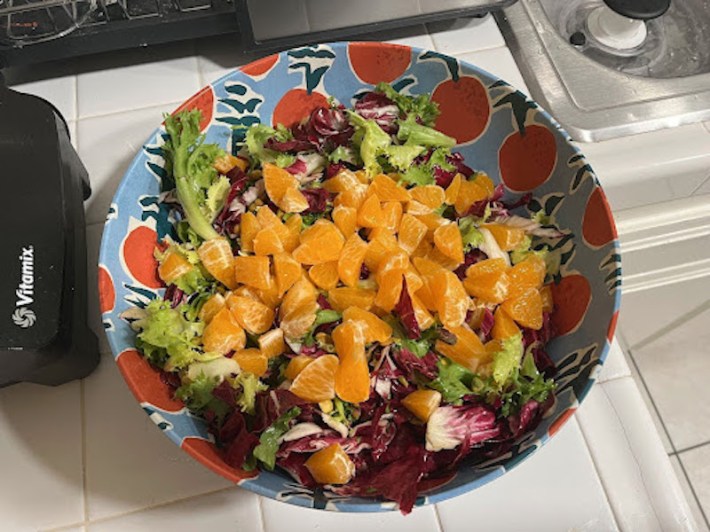
Present the Big Salad to the table, then toss the creamy goo into the rest of the salad. Tell your guests what’s in it, and watch them marvel at the idea that you are allowed to basically just put cream in salad, if you want. What a world. Eat the salad with them while the potatoes cook.
But I hear you ask: Where’s the beef? Don’t fucking get mad at me. You said it, not me. Dumbass joke, in my opinion.
The recipe I have always used is Julia Child’s, slightly adapted on the blog Cafe Delites. I am something of a snob about recipe blogs, for really no reason other than that a lot of them are insane. This recipe has never let me down. However, because this isn’t The Perfect Dinner Party Club, I do skip some steps. Our friendly blogger pleads with us not to skip the step where you strain the sauce back into the pot and thicken it separately, and I put my cigarette out on her keyboard, lower my sunglasses, and say “No.” Then I drive into the sunset on my motorbike, sipping a cup of thinner-than-it-should-be beef juice.
But seriously, I have done that step maybe once, and it does make the liquid thicker and more impressive, but is it enough to justify the whole straining step? The beef flecks in your sink? Only you can answer that question. You can also just leave the meat in and let it simmer a bit on the stovetop with the lid ajar, and it isn’t going to make the beef tough if you don’t do it for, like, ages and ages.
This time, I did find the liquid a little thinner than I’d like, possibly because I put too much stock in the pot to begin with and took the beef out a little earlier than usual. (Speaking of liquid, she also uses a $20 bottle of pinot noir, which is a bit much for me. I always use a $8-ish bottle from Trader Joe’s, usually this one, and I enjoy my leftover glass.) My colander was already dirty from making the potatoes, and I wasn’t about to wash it. Guess which of these happened:
- My guests, appalled at my lack of respect in serving them beef in slightly thin juice, poured their wine in my lap and walked out. They called the police, who came to my apartment and blew me up.
OR:
- My guests were delighted and touched at the effort I had gone to in making dinner for them, took photos of the food, and told me what a wonderful meal it was.
You got it: They loved it. These fools (thank you again to Sam Biddle, Emma Carmichael, and Casey Johnston for being such pleasant and sweet guinea pigs) had no idea what a devious trick I had just pulled on them.
You are going to want to have the following, to serve around six people with a little bit of leftovers:
- Three pounds of big beautiful BEEF. I used a chuck/pot roast from the normal-ass grocery store, which was slightly less than 3 pounds. You can also use brisket, apparently, but I’ve only ever used chuck.
- Six ounces of bacon, but I think I used more like three ounces this time due to it was what we had left in the fridge. Use lardons if you’re posh.
- Carrots. I usually put in two instead of one. I like them!
- An onion (regular type).
- The aforementioned bottle of red wine. We are going to use at least Most and as much as All of this bottle.
- Beef stock. You shouldn’t need more than two cups.
- A tube of tomato paste, from which you will take two tablespoons. The can may tempt you but the tube is superior.
- Six cloves of garlic, two of which are for your mushrooms.
- Your mushrooms. The recipe says use a pound; I used eight ounces and did not feel shortchanged.
- Two tablespoons of flour.
- Fresh thyme and dried bay leaves, fake as the latter may be; treat yourself to a new bag, maybe, to ensure they're as not-fake as possible. Parsley for the top if you have a plant of it.
- Salt and pepper. I know, but I have to say it. Also, make sure you find some Diamond Crystal kosher salt instead of Morton, which is pointlessly huge and prone to ruining recipes. They almost always mean Diamond Crystal.
Budget an hour for the first stages—chopping stuff, browning beef, etc. It should take about 2-3 hours for the beef itself to cook. If you check the pot part of the way through cooking and find it is bubbling a lot, turn the oven down a bit.
Here’s the order of operations roughly as I did it:
- Prep your borg ingredients: Cube the beef, slice the bacon, chop the onion and your washed but not peeled carrot, smash the garlic. Chop some shallots for your beans later, too, and put them in a pleasingly small cup or Tupperware. Here’s about half the beef, cubed and salted and peppered.

- While you’re browning the beef cubes in batches (it’s good to get some real color on each piece but don’t feel you have to get a perfect sear on every surface), wash your salad leaves. If you have a salad spinner, deploy it. I spun and dumped the water many times, then scattered the leaves over a clean tea towel and let them dry. I also washed and chopped my mushrooms into nice even-ish pieces, and wrapped them in another towel.
- Do the borg stuff: Move the beef to a plate, add vegetables and garlic to the pot, cook for a bit, beef back in, flour in, stir it around for a minute or two. I cook the tomato paste for a minute before adding the liquid. If you’re using the three cups of wine that the recipe recommends, you will have just a little bit left over, which you can either add to the beef or drink. This is what mine looked like when it went in.
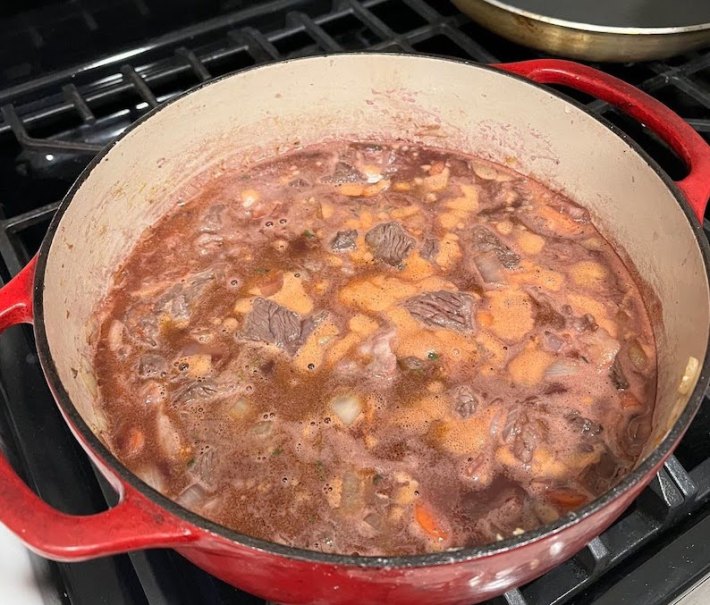
- The borg is in. It will cook for 2–3 hours. For about an hour of that, I sat in my recliner on the balcony and tried to snooze, but I had too much uncomfortable, anxious energy, so I folded laundry instead.
- Potatoes! About an hour before people arrived, I peeled the potatoes. I started setting the table and then forgot what I was doing after I put the forks down, causing my husband to laugh at me.
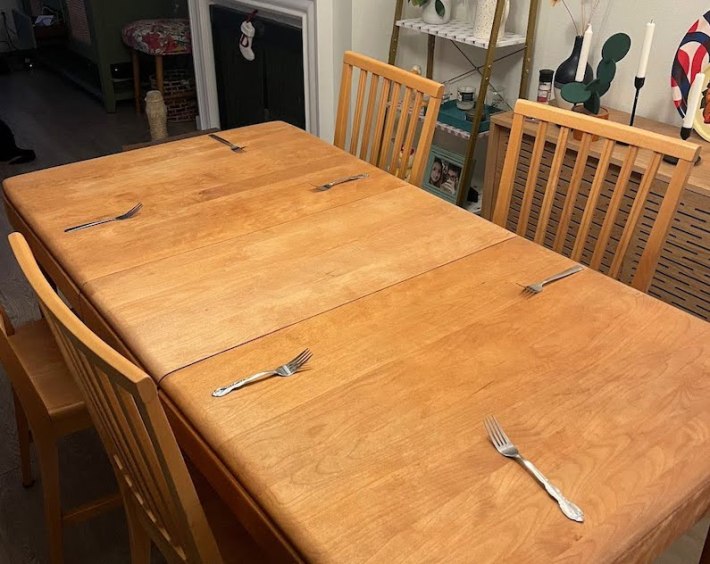
- After the borg had cooked for about 2–2.5 hours, I took it out of the oven and found the beef was fork-tender. Immediately I set the oven to 400 on the convection setting and chopped my 2.8 pounds of gold potatoes into quarters, eighths for bigger boys. I boiled them for 10 minutes while the oven heated, did the thing where you shake them violently in the colander, tossed them in oil and put them in the oven. I skipped the stuff with the garlic and herb infused oil; sorry, Kenji, but I was tired. The table was also set correctly at this point.

- Friends have arrived! You have served them wine and they are chatting happily. Dress the salad just before you serve. I do this in a separate bowl then scatter it over the labne for maximum effect, but honestly, do it all together if you don’t want to dirty a bowl.
- Eat salad with your guests. It’s a good one to have with a chilled red, orange, or whatever cool refreshing wine, or non-alcoholic beverage, you have. Check the potatoes every now and then. Give them a shake and a stab. At some point I turned the heat on under the beef, medium or something, so it was bubbling and thickening a bit. This is what it looked like when it came out. As you can see, I didn’t do the fat-skimming steps earlier or ever, and I don’t care. Mmm, fat.
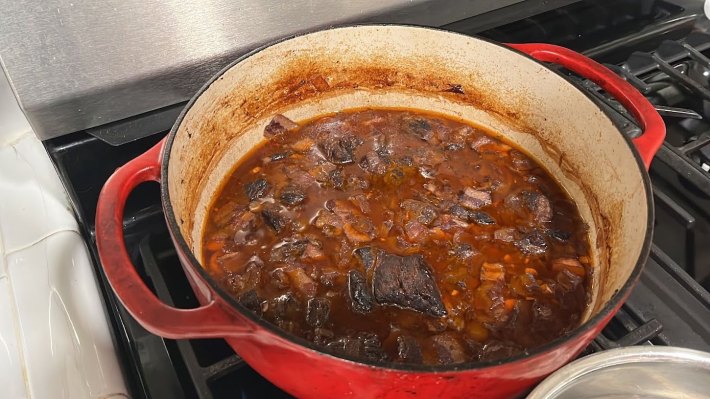
- SHIT!! I FORGOT THE MUSHROOMS! Just kidding, this is what you’re supposed to do. While the juice is thickening, I melted a huge knob of butter in a nonstick skillet and let the mushrooms cook in there, with a hastily chopped garlic clove, until they were soft and brown. I dumped them into the pot and used the pan for the green beans without washing it.
- Yes, green beans were next. I bought some haricots verts (good, thinner beans) from Trader Joe’s. I followed Pepin’s recipe exactly.
- The potatoes are ready! Here’s an insane photo I took of them.

- Slop everything onto a plate and bring it out to oohs and ahhs. Serve with a Regular Red Wine like merlot or something. Who fucking knows what kind. The type of red wine that says meat on the back of it.
- Eat. Drink. Here is a photo taken by one of my guests. I like how the potatoes look like a row of boulders that you have to put in the right order in a video game.
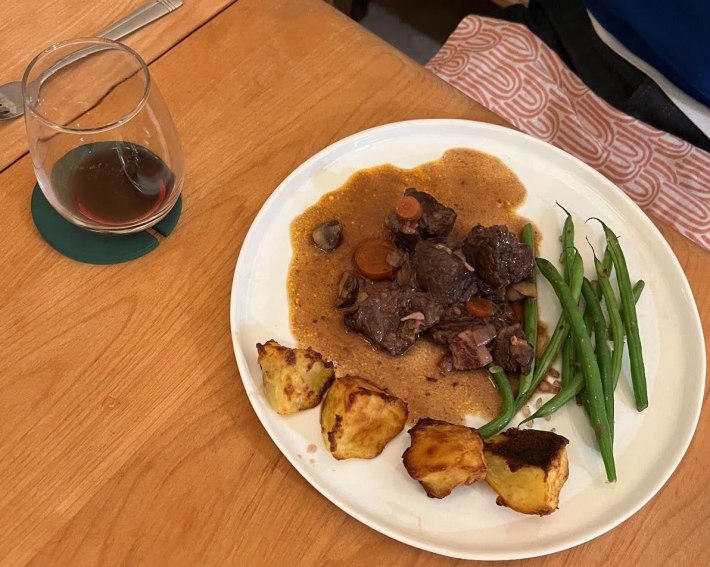
Now, the extra credit: Dessert. It is completely normal and perhaps even encouraged to buy some sort of prepared dessert. A half or full pie from the grocery store, served with vanilla ice cream. If you do want to make your own dessert, it makes a lot of sense to serve something you can make mostly or entirely the night before. A lemon tart, perhaps.
What I did was slightly mental, because I draw energy from the impressed-but-concerned expressions of guests when I return to the kitchen and start whipping egg whites, which they can see through the old-fashioned Wall Hole we have (what is that called?). I made the NYT’s lemon pudding cake, which I’ve served before, because I just adore citrus desserts and the recipe is reassuringly short.
I had pre-measured my dry ingredients into a tupperware earlier and filled the 13x9 pan with water, so the only real work I had to do after dinner was separating eggs. I measured the milk and microwave-melted butter into a bowl, added egg yolks and lemon juice, and dumped in the drys. I have a stand mixer, so I set the egg whites whipping while this was happening, and kept an eye on their peaks. Once they were ready, I folded them into the rest of the mix until it seemed fairly incorporated but still light, poured it into the buttered dish, and popped that into the water bath, and into the oven; 45 minutes on the timer, and I rejoined the table. Then we watched YouTube videos where this strange swinger couple review dark, nasty swinger clubs until the pudding was ready.
I had made a little raspberry sauce earlier: cooked down raspberries with sugar and lemon until they were reduced, added more of each as needed, then stored the goo in a tupperware in the fridge. Again, very much extra credit, not required. Plop the pudding cake into bowls—it should have separated into a layer of jiggly pudding-curd, and a layer of light yellow cake—and add a drizzle of raspberry, and you have an impressive, delicious, comforting dessert.
At the end of the night, there were a lot of dishes, so we filled the dishwasher and went to bed. That is tomorrow’s problem, and dishes can be washed on your schedule. The borg is even better the next day, so my husband and I were fed for a couple more nights.
I hope you will make this meal for your friends, and enjoy your own versions of this party: Perhaps a different salad, a different potato (mashed is great), a different dessert. Definitely different YouTube videos. Please, if you make this meal, let me know. Tell me about your friends, your conversations, your witty remarks. And, if you had fun, do join me for next month’s Perfectly Fine Dinner Party Club.
